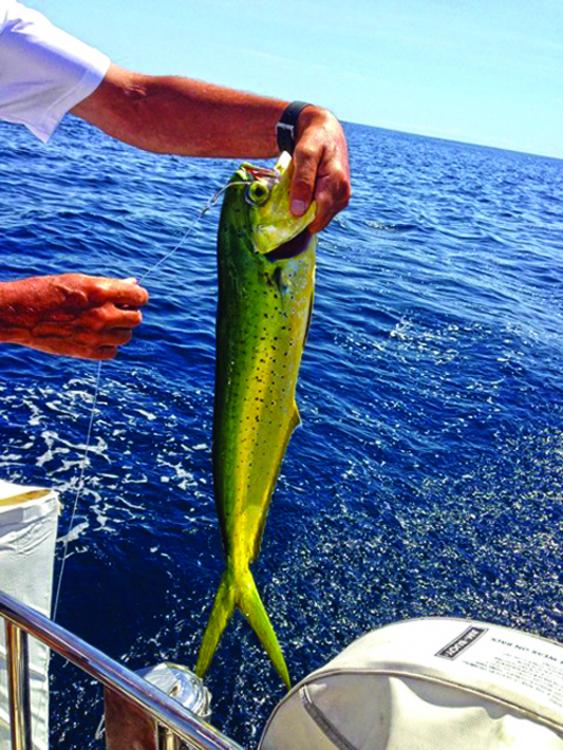How to Catch Fish Under Sail, and What To Do Once You Have One
My favorite fishing spots are Whole Foods and Wild Country Seafood in Annapolis. I don’t have the patience to stand around for hours with a fishing rod in my hand. Drinking beer in the hot sun gives me a headache. But, on an offshore sailing passage, I’ll gladly make a minimal effort to substitute fresh mahi mahi for a frozen or freeze-dried dinner menu.
On any offshore passage, your chances of catching fish by trolling a line behind the boat are good. The most frequently caught species in the mid-Atlantic are mahi mahi, wahoo, and tuna. You can use any conventional trolling rod. I prefer a hand line. It is cheaper, simpler, and takes up less room on the boat.

Buy 50 yards of 500-pound test monofilament. You are not going to catch a 500-pound fish, but the large gauge of the line is easier on your hands. Also get appropriate sized metal crimps. Crimp a loop on one end big enough to go over a stern cleat. On the other end, crimp a strong snap swivel. Also buy a three-ounce bullet sinker with an eye on each end. The sinker will keep the lure a little below the surface where it is less likely to snag seaweed.
Do not buy lures that are as big as your forearm. They are for catching big fish. You don’t want to wrestle and dress a 50-pound fish on your teak deck or sugar scoop. A 10- to 15-pound fish will feed the crew for a couple of days with much less fuss.
Choose lures about six to eight inches long. They should have a blunt or pointed head of metal or plastic and long, multi-colored trailing plastic tentacles like a squid. If it comes with a leader, it will be monofilament. You may need to crimp a barrel snap to the end where there is only a loop. If it has no leader, buy some wire leader material and the appropriate crimps.
Make up a four-foot-long piece of one-quarter inch bungee (any color) with a loop in one end that will fit over the stern cleat and a loop in the other end about two inches long. Wind the whole rig around a bleach bottle or a piece of plywood or buy the plastic spool displayed next to the line at the tackle store.
Stream the line, weight, and lure behind the boat. Speed doesn’t matter. You can catch fish trolling at three knots or nine knots. Attach one end of the bungee to the same stern cleat as the line. Grab the line about eight feet from the cleat, make a loop in it, and tie the loop to the small end of the bungee with a double becket bend (Google it).
When the fish hits the lure, the bungee will take the shock. You, the attentive fisherman, will know you have a fish on, or seaweed or trash, when you see the bungee stretch. Cleaning and preparing the fish can also be simple. Insert a very sharp and slightly flexible knife through the fish near the tail and perpendicular to the backbone with the handle toward the dorsal ridge along the top of the fish. With the business edge of the knife toward the head, carefully work the knife toward the head keeping it close to the backbone and the dorsal ridge. When you reach the pectoral fin, stop and make an angular cut at the pectoral fin freeing the fillet from the carcass except where it is joined at the tail. Repeat on the other side.
There is no need to skin the fish unless you would like to serve it as sushi or sashimi. I recommend skinning it. Lay one fillet flat, skin side down, and hold it by the tail. Cut into the meat at a forward angle near the tail and carefully work the knife forward with a slight downward pressure on the blade against the skin until the fillet comes free.
For sushi or sashimi, partially freeze the meat, slice it into longitudinal strips, and then slice across the strips to make bite sized pieces about one-quarter inch thick. For sashimi, marinate in a combination of fresh citrus juice and soy sauce for 30 minutes. Serve with wasabi.
For cooking, roll in flour or corn meal, salt, and pepper and sauté in butter or oil, with or without garlic. Or, bake in the oven at 375 degrees Fahrenheit, skin side down, for about 20 minutes depending on thickness. Because some wild fish can be dry, baste before baking with oil, salad dressing, mayo, or something like pesto.
Fresh fish adds enormously to the pleasure of any passage under sail. Don’t miss the opportunity.
For more articles about cruising, click here!
For more articles about fishing, check out our sister magazine, FishTalk!




